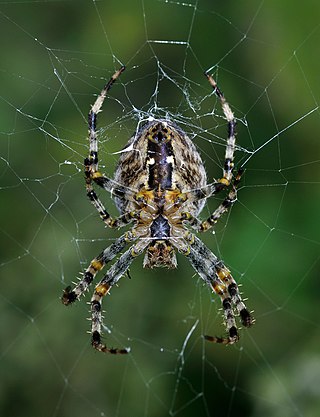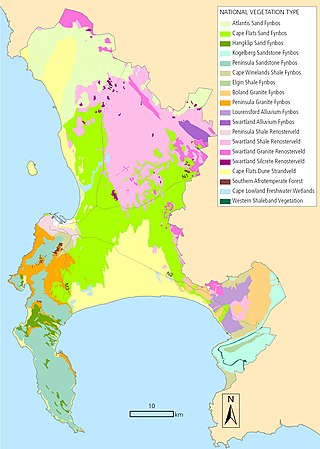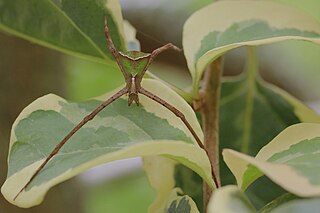
The wagtails, longclaws, and pipits are a family, Motacillidae, of small passerine birds with medium to long tails. Around 70 species occur in five genera. The longclaws are entirely restricted to the Afrotropics, and the wagtails are predominantly found in Europe, Africa, and Asia, with two species migrating and breeding in Alaska. The pipits have the most cosmopolitan distribution, being found mostly in the Old World, but occurring also in the Americas and oceanic islands such as New Zealand and the Falklands. Two African species, the yellow-breasted pipit and Sharpe's longclaw, are sometimes placed in a separate seventh genus, Hemimacronyx, which is closely related to the longclaws.

Jumping spiders are a group of spiders that constitute the family Salticidae. As of 2019, this family contained over 600 described genera and over 6,000 described species, making it the largest family of spiders at 13% of all species. Jumping spiders have some of the best vision among arthropods and use it in courtship, hunting, and navigation. Although they normally move unobtrusively and fairly slowly, most species are capable of very agile jumps, notably when hunting, but sometimes in response to sudden threats or crossing long gaps. Both their book lungs and tracheal system are well-developed, and they use both systems. Jumping spiders are generally recognized by their eye pattern. All jumping spiders have four pairs of eyes, with the anterior median pair being particularly large.

Deinopidae, also known as net casting spiders, is a family of cribellate spiders first described by Carl Ludwig Koch in 1850. It consists of stick-like elongated spiders that catch prey by stretching a web across their front legs before propelling themselves forward. These unusual webs will stretch two or three times their relaxed size, entangling any prey that touch them. The posterior median eyes have excellent night vision, allowing them to cast nets accurately in low-light conditions. These eyes are larger than the others, and sometimes makes these spiders appear to only have two eyes. Ogre-faced spiders (Deinopis) are the best known genus in this family. The name refers to the perceived physical similarity to the mythological creature of the same name. This family also includes the humped-back spiders (Menneus).

The honey badger, also known as the ratel, is a mammal widely distributed in Africa, Southwest Asia, and the Indian subcontinent. Because of its wide range and occurrence in a variety of habitats, it is listed as Least Concern on the IUCN Red List.

Solifugae is an order of animals in the class Arachnida known variously as camel spiders, wind scorpions, sun spiders, or solifuges. The order includes more than 1,000 described species in about 147 genera. Despite the common names, they are neither true scorpions nor true spiders. Most species of Solifugae live in dry climates and feed opportunistically on ground-dwelling arthropods and other small animals. The largest species grow to a length of 12–15 cm (5–6 in), including legs. A number of urban legends exaggerate the size and speed of the Solifugae, and their potential danger to humans, which is negligible.

The Cape hare, also called the brown hare and the desert hare, is a hare native to Africa and Arabia extending into India.

The Cape cormorant or Cape shag is a bird endemic to the southwestern coasts of Africa.

The Entelegynae or entelegynes are a subgroup of araneomorph spiders, the largest of the two main groups into which the araneomorphs were traditionally divided. Females have a genital plate (epigynum) and a "flow through" fertilization system; males have complex palpal bulbs. Molecular phylogenetic studies have supported the monophyly of Entelegynae.

The Cape weaver is a species of bird in the weaver family, Ploceidae, found in southern Africa.

The Cape bunting is a passerine bird in the bunting family Emberizidae.

Sebastes capensis, the false jacopever or Cape redfish, is a species of marine ray-finned fish belonging to the subfamily Sebastinae, the rockfishes, part of the family Scorpaenidae. It is found in the South Atlantic Ocean and may also occur off southern and western South America.

Deinopis longipes is a species of net-casting spider. It is found throughout Central America.

Steatoda capensis is a spider originating from South Africa. Its common names include the black cobweb spider, brown house spider, cupboard spider and due to its similarities to the katipō spider it is commonly known as the false katipō in New Zealand. Common throughout Southern Africa, it has been introduced into other countries and is now present in Australia and throughout New Zealand. It is a small spider, usually an all-over shiny black. It may have a small bright red, orange, or yellow patch near the tip of the abdomen along with a crescent shaped band near the front of the abdomen.

The Biodiversity of Cape Town is the variety and variability of life within the geographical extent of the City of Cape Town metropolitan municipality, excluding the Prince Edward Islands. The terrestrial vegetation is particularly diverse and much of it is endemic to the city and its vicinity. Terrestrial and freshwater animal life is heavily impacted by urban development and habitat degradation. Marine life of the waters immediately adjacent to the city along the Cape Peninsula and in False Bay is also diverse, and while also impacted by human activity, the habitats are relatively intact.

Menneus is a genus of net-casting spiders that was first described by Eugène Simon in 1876. It includes the former genera Avella and Avellopsis. Species are found in Australia, New Caledonia, and eastern and southern Africa. Originally placed with the cribellate orb-weavers, it was moved to the Deinopidae in 1967.

Menneus nemesio is an Australian species of net-casting spider in the family Deinopidae. This diurnal species is often found in vegetation near water, low to the ground. Usually a brown spider, though it is occasionally seen with a green abdomen.

Asianopis is a genus of Asian net-casting spiders first described by Y. J. Lin, L. Shao and A. Hänggi in 2020.

Menneus camelus, also known as the camel-back spider, is a species of net-casting spider in the family Deinopidae. It is endemic to eastern South Africa.


















